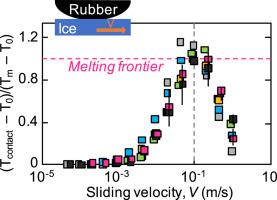Tribology International ( IF 6.2 ) Pub Date : 2021-06-11 , DOI: 10.1016/j.triboint.2021.107129 S. Hemette , J. Cayer-Barrioz , D. Mazuyer

|
This work presents an experimental analysis of the friction response of an ice-rubber interface over five decades of sliding velocity and temperature down to − 20 ∘C, combining in-situ contact visualisation and simultaneous force measurements. Viscoelastic properties of the rubber were varied in terms of glassy temperature transition and elastic modulus. Based on the in-situ contact area measurements, the adhesive and viscoelastic contributions were identified. Even though a bell-shape friction-velocity curve was observed, the classical WLF transform did not allow a description of the friction behaviour. A simple analytical model accounting for the thermal dissipation induced by friction was thus proposed and a dimensionless master curve was obtained with the sliding velocity, regardless of the temperature and the material properties. From this master curve, a predictive friction model was proposed, in which both friction contributions, adhesion-viscoelasticity and thermal dissipation, were multiplicative rather than simply additive.
中文翻译:

冰-橡胶摩擦机制中的热效应与粘弹性
这项工作结合了原位接触可视化和同步力测量,对冰-橡胶界面在滑动速度和温度低至 − 20 ∘ C 的五年内的摩擦响应进行了实验分析 。橡胶的粘弹性在玻璃态温度转变和弹性模量方面有所不同。基于现场接触面积测量、粘合剂和粘弹性贡献被确定。即使观察到钟形摩擦速度曲线,经典的 WLF 变换也不允许描述摩擦行为。因此提出了一个简单的分析模型来解释摩擦引起的热耗散,并获得了具有滑动速度的无量纲主曲线,而与温度和材料特性无关。根据该主曲线,提出了一个预测摩擦模型,其中摩擦贡献、粘附-粘弹性和热耗散都是乘法而不是简单的相加。



























 京公网安备 11010802027423号
京公网安备 11010802027423号